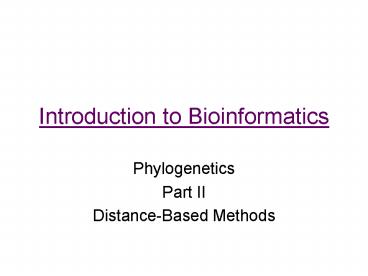Introduction to Bioinformatics PowerPoint PPT Presentation
1 / 14
Title: Introduction to Bioinformatics
1
Introduction to Bioinformatics
- Phylogenetics
- Part II
- Distance-Based Methods
2
Distance Matrix
- (Evolutionary) Distance
- Many possible measures
- Fraction of sites that differ between two
sequences - of changes needed to convert one sequence to
another (count mismatches, substitution models,
) - Distance Matrix
- Matrix of pairwise distances between all
sequences - Used to generate tree
- Varies with construction method, distance metric
3
Distance in Phylogenetic Tree
- Distances are ultrametric if
- Same rate of change on all branches in tree (rare
in practice) - All leaves equidistant from root
- Also known as a molecular clock
- Distance matrix must satisfy the following
3-point condition - For any three leaves i, j, k, distances dij, dik,
djk - two of three distances are equal and third
4
Distance in Phylogenetic Tree
- Distances are additive if
- Distance between any two leaves i j on tree
sum of lengths of edges connecting i j - Distance matrix must satisfy the following
4-point condition - For any four leaves i, j, k, m, two of the
distances dijdkm, dikdjm, dimdjk are equal and
greater than the third - In fact, the difference is 2 x the length of the
bridge edge(s)
5
UPGMA
- UPGMA (Unweighted Pair Group Method using
Arithmetic Averages) Sokal Michener 1958 - Algorithm
- 1. Find pair of sequences (or clusters) A, B with
smallest distance dAB - 2. Insert join for A, B at tree height ½ dAB.
A and B thus form a new cluster. - 3. Update distance of any other sequence/cluster
X to new cluster as ½ (dAX dBX) - 4. Repeat until all sequences / clusters joined
- 5. Produces rooted tree
- Assumptions
- Distances for tree are ultrametric
- Branch lengths for 2 leaves same after join
- Distances for tree are additive
similar algorithms vary at this step
6
UPGMA Example
- Given sequences
- Build distance matrix
7
UPGMA Example
- Form clusters
- Next step?
8
Transformed Distance Method
- Weakness of UPGMA
- Assume constant evolution rate across lineage
- Example Consider sequences A, B, C, and D is
Figure 4.5. UPGMA cluster A and C first. - Transformed Distance Method J. Farris, 1977
- Take advantage of the power of an outgroup
- Similar to UPGMA except for the distance matrix
- Algorithm
- Select an outgroup D
- Transformed distance between i and j
- dij (dij diD djD)/2 (?dkD)/n
- where n is ingroups
- Run UPGMA with matrix of dij
9
Transformed Distance Method
- Example
- Select D as the outgroup
- Calculate transformed distance
- (?dkD)/n (dAD dBD dCD)/3
- (12 15 10)/3 37/3
- dAB (dAB dAD dBD)/2 37/3
- (9 12 15)/2 37/3 10/3
- dAC (dAC dAD dCD)/2 37/3
- (8 12 10)/2 37/3 16/3
- dBC (dBC dBD dCD)/2 37/3
- (11 15 10)/2 37/3 16/3
- Construct new distance matrix
- Run UPGMA
10
Transformed Distance Method
- Example (contd)
- How do you compute the length of a lineage?
11
Neighbor-Joining Method
- Goal
- Join closest neighbors (nodes w / same parent) in
tree - Avoids problem with UPGMA when rates of change
differ - Example
- Closest leaves not neighbors in correct tree, but
joined first by UPGMA (see previous example) - Assumptions
- Rate of change can differ
- Branch lengths may differ after join
- Branch lengths for tree are additive
12
Neighbor-Joining Method
- Approach
- To find closest pair of neighbors
- Reduce branch length for a node by
(approximately) the average distance of the node
from all other nodes - Find smallest distance between nodes (after
reduction) - Definitions
- For all pairs of nodes A B in set of all nodes
L, let - dA,B distance between A,B
- RX ? dX,N where N ? L (total distance from X to
all N) - rX RX / (n 2),where n of nodes
- (normalized divergence from X to all other nodes)
- QA,B (n 2) dA,B (RA RB) (rate-corrected
distance) - Key property - 2 nodes w/ minimum Q are always
neighbors!
13
Neighbor-Joining Method
- Algorithm Saitou Nei 1987, Studier Keppler
1988 - 1. Begin with star tree all sequences as nodes
in L - 2. Find pair of nodes A B ? L with minimum QA,B
- 3. Create insert new join (node K) w/ branch
lengths - dA,K ½ (dA,B rA rB)
- dB,K ½ (dA,B rB rA)
- 4. For remaining nodes C ? L, update distance to
K as - dK,C ½ (dA,C dB,C dA,B)
- 5. Insert K and remove A, B from L
- 6. Repeat steps 2-5 until only two nodes left
K
A
B
14
Neighbor-Joining Method
- Example

